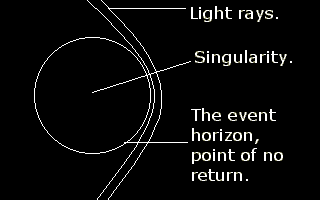|

Image copyright © 1998 by John
Chang.
حال سیاه
چاله ای را در نظر بگیرید که بين
زمين و يك جسم سماوي ديگر مانند ستاره قرار گرفته باشد و
نور آن براي رسيدن به زمين از كنار آن بگذرد. دو پرتو نوري
كه از آن متصاعد شدوه و از دو طرف سیاه
چاله عبور
مي كنند، اين
دو پرتو توسط سیاه
چاله مياني
نخست واگرا مي شوند و دوباره همگرا مي گردند و سیاه
چاله مياني
مانند يك عدسي رفتار مي كند.
سیاه چاله را می توان از روی شدت کانونی شدن نور تشخیص داد.
Albert Einstein's theory
of general
relativity proposes
that the most densest and massive objects conceivable,
such as black holes, have gravity that is so strong that
nothing, not even light, can escape their grasp. So if
light is not given off by black holes, how do we detect
them? It would seem that attempting to detect a black
hole would be "a bit like looking for a black cat in a
coal cellar" (Hawking 121). Following are just four ways
in which black holes can (and have been) detected.
When a star collapses
and changes into a black hole, the strength of its
gravitational field still remains the same as it had
been before the collapse. Therefore the planets in orbit
would not be affected. The planets would continue in
their orbits as usual and would not be drawn into the
black hole. Because black holes do not give off any
light, the planets would appear to be orbiting around
nothing. There is reason to believe that the planets
could just be orbiting about a star that is too faint to
be seen, but there is an equal chance that a black hole
could be present (Hewitt 187).
Because the gravity of a
black hole is so intense, dust particles from nearby
stars and dust clouds are pulled into the black hole. As
the dust particles speed and heat up, they emit x-rays.
Objects that emit x-rays can be detected by x-ray
telescopes outside of the Earth's atmosphere (Miller).
Black holes can be
detected through a technique called gravity
lensing.
Gravity lensing occurs when a massive object, in this
case a black hole, passes between a star and the Earth.
The black hole acts as a lens when its gravity bends the
star's light rays and focuses them on the Earth. From an
observer's point of view on the Earth, the star would
appear to brighten. Einstein's general relativity theory
suggests that light should follow the path of bent time
and space, which in this scenario, is bent by the black
hole's gravity (Miller).
Black holes can be
detected by measuring how much mass there is in a
certain region of space. Black holes have large, dark
masses concentrated in small volumes. If a region has
large amounts of this dark mass, then one can suspect
the presence of a black hole. |



